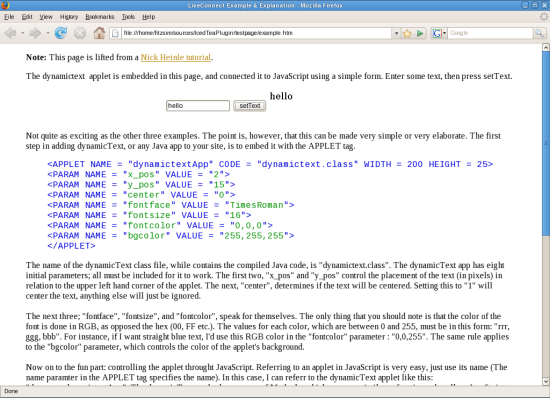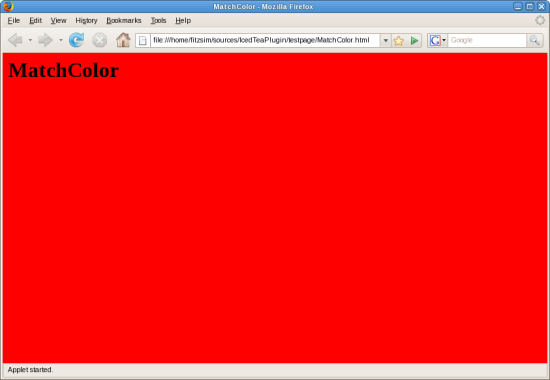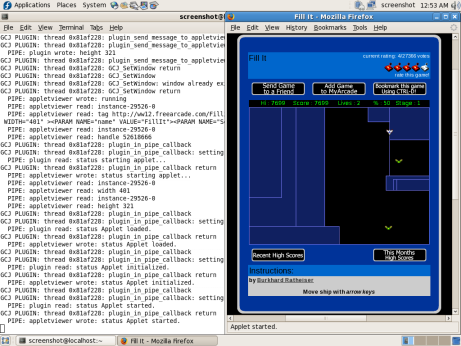CommunityOne 2008
Monday, May 5
I thought my CommunityOne talk, The IcedTea Project: Developing OpenJDK for Deployment on GNU/Linux, went pretty well. The audience was small but full of important people 🙂 Martin Buchholz introduced himself after my presentation and we chatted a little about Google’s plans to contribute to OpenJDK. After the talk I was interviewed briefly by a reporter from InfoWorld.
I arrived at the presentation room halfway through the Lightning Talks session that preceded mine. One demo really jumped out at me: an astronomy viewer that the speaker was porting from C++ to Java. I can’t remember its name and Google didn’t turn it up readily but it was a very impressive demo.
After my talk I dropped in for the last half of Karsten Wade’s Insight into the Fedora Distro and Community. I thought it was a nice blend of high-level observations on community building and real world examples of how the Fedora project engages contributors. Later that day, Patrick Macdonald, Karsten and I recorded a podcast with Sun’s Barton George.
JavaOne 2008
Tuesday, May 6
The keynote was fun. Both the Kindle and JavaFX demos were problematic, apparently because Moscone’s wireless network was unreliable. Rich Green covered with a good line: “This shows that the JavaOne demos are live, not pre-recorded”. I had heard Neil Young would be there explaining “what Java means to him” which I thought was pretty funny. I was expecting a contrived marketing spiel but of course Neil Young kept it real with a convincing story about his use of Java (he’s producing digital archives of his life’s work). Best quote of the keynote: Neil Young: “We’ve got some demos to show you. Now these are fake, so we know they’re gonna work.”
Later on Tuesday I attended Is There a Place For Applets in Web 2.0?. There I learned about the upcoming JRE u10 plugin features, including JRE version selection and the new one-JVM-per-applet model (which gcjwebplugin uses for the sake of simplicity). I was surprised to learn that >= 1.5 JREs provide DOM APIs through LiveConnect. The speakers promoted a “cool applets” blog which I’ve been following.
Wednesday, May 7
I co-presented Growing Open Source Developer Communities with Dalibor Topic. I really appreciated Dalibor inviting me to speak with him. This talk was well-attended; about 130 people showed up. I had never co-presented before but I enjoyed the experience — preparing over tea at the amazing Samovar Tea Lounge was great fun. There were some good questions from the audience both during Q&A and after the talk so I think it was well-received.
Next, I chatted with David Herron about OpenJDK testing strategies for Red Hat’s packages. David gave me some suggestions about how best to apply the newly-freed jtreg harness in our processes. We also briefly discussed how to share TCK test results between Red Hat and Sun.
Mark Reinhold’s OpenJDK Community Update covered a story that was mostly familiar to me (he attended my talk, which I’m sure was familiar to him :-)), but also broke news about community governance. The deadline for writing the OpenJDK project’s constitution was this year’s JavaOne, but it’s been extended to next year’s JavaOne. And since Dalibor had joined Sun, the governance board seated three Sun employees and two non-Sun members. To address this Sun added two more seats to the board.
Later that night I dropped in on the tail end of the modules BOF, Modularity in the Java Platform: Demos and Q&A. Unfortunately it was the last session and security personnel ushered us out before I had a chance to chat with Alex Buckley.
On Tuesday and Wednesday I spent some time wandering through the JavaOne pavilion. Highlights:
- Intel’s Itanium port of Sun’s Java: This is almost complete and is due out later this year. Unfortunately it seems this won’t go into OpenJDK.
- Second Life: Sun had set up a Second Life replica of the JavaOne pavilion — recursively creepy!
- Wonderland preview: Wonderland is a Sun project similar to Second Life but with tricked-out 3D audio, shared whiteboards and in-world shared X windows.
- Java realtime demo: This was a series of tubes that sorted falling coloured balls according to selections made in a Swing GUI. I was able to temporarily jam the sorter by exploiting a GUI/sorter race condition, hehehe.
Thursday, May 8
The Open Source Development Tools for the Java Platform, Enterprise Edition (Java EE Platform), Web 2.0, and SOA talk introduced me to Drools. The presenters demoed modifying the canonical “online store” Java EE application from the point of view of developers, store employees and store customers. The graphical tools seemed pretty impressive — they allowed effortless connections to be established between pre-made components resulting in automatic updates to the employee/customer “workflows”.
Later I recorded another podcast, this time with Dalibor Topic for Sun’s OpenJDK blog.
Thursday night was the OpenJDK Porters’ BOF where I described Gary Benson’s work on IcedTea porting: his libffi port and Shark, his LLVM port. Jonathan Springer described his 64-bit MIPS port, and Volker Simonis described SAP’s porting efforts: 64-bit server JITs for PowerPC, Itanium and zSeries.
Friday, May 9
On Friday afternoon I attended the lab, “OpenOffice.org Extensions with NetBeans”. The tutorials were very well-organized. Once you’re familiar with the terminology — that is, once you know which wizards to invoke — it’s fairly straightforward to create first-class OO.o UI elements with NetBeans and the Java-to-UNO bridge.
Wrap-up
I talked to Jaroslav Tulach about progress getting NetBeans packaged and into Fedora. I also chatted with Chok Poh and Marc Schoenefeld (great to finally meet Marc in person!) about handling JDK security updates. I wanted to meet with Kenneth Russell, team lead for the new Java plugin, but our paths didn’t cross.
Dalibor was very helpful throughout the week facilitating various meetings and I appreciated his efforts to get good exposure for IcedTea, Fedora and Red Hat’s efforts in general. Plus he was a great drinking buddy 🙂 On that note, it was great to meet up with friends throughout the week: Casey Marshall, Erinn Clark, Alex Gravely, John McCutchan, Tom Marble and all the familiar members of Sun’s OpenJDK team.


